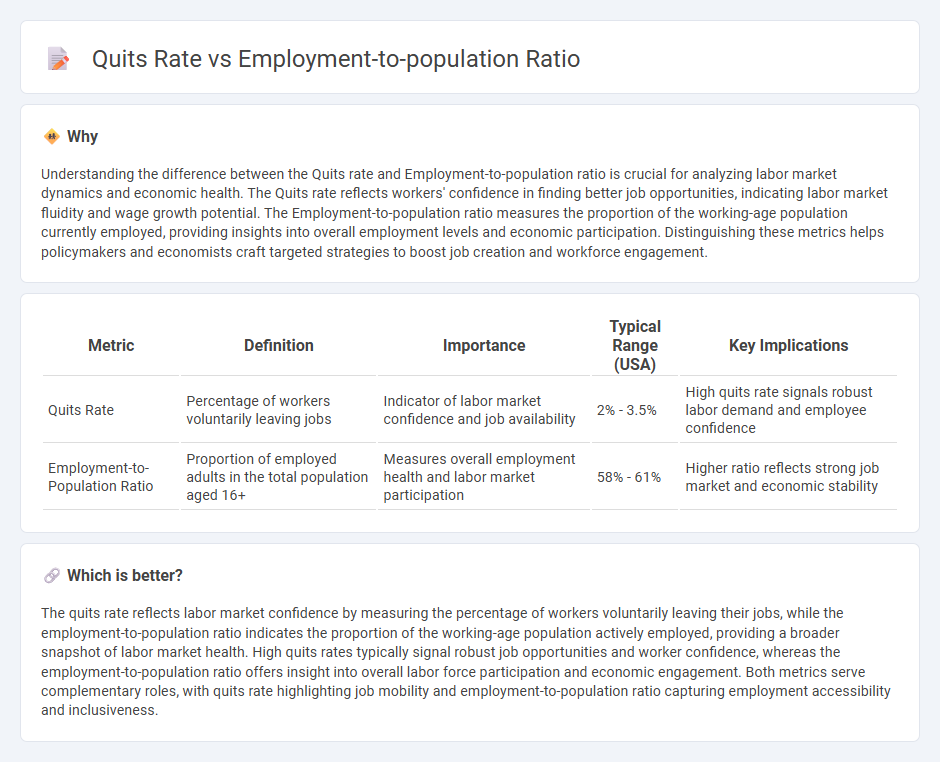
The quits rate measures the proportion of workers voluntarily leaving their jobs, reflecting confidence in labor market conditions and job availability. The employment-to-population ratio indicates the percentage of the working-age population currently employed, providing insights into labor market participation and economic health. Explore the dynamics between these two indicators to better understand workforce trends and economic resilience.
Why it is important
Understanding the difference between the Quits rate and Employment-to-population ratio is crucial for analyzing labor market dynamics and economic health. The Quits rate reflects workers' confidence in finding better job opportunities, indicating labor market fluidity and wage growth potential. The Employment-to-population ratio measures the proportion of the working-age population currently employed, providing insights into overall employment levels and economic participation. Distinguishing these metrics helps policymakers and economists craft targeted strategies to boost job creation and workforce engagement.
Comparison Table
| Metric | Definition | Importance | Typical Range (USA) | Key Implications |
|---|---|---|---|---|
| Quits Rate | Percentage of workers voluntarily leaving jobs | Indicator of labor market confidence and job availability | 2% - 3.5% | High quits rate signals robust labor demand and employee confidence |
| Employment-to-Population Ratio | Proportion of employed adults in the total population aged 16+ | Measures overall employment health and labor market participation | 58% - 61% | Higher ratio reflects strong job market and economic stability |
Which is better?
The quits rate reflects labor market confidence by measuring the percentage of workers voluntarily leaving their jobs, while the employment-to-population ratio indicates the proportion of the working-age population actively employed, providing a broader snapshot of labor market health. High quits rates typically signal robust job opportunities and worker confidence, whereas the employment-to-population ratio offers insight into overall labor force participation and economic engagement. Both metrics serve complementary roles, with quits rate highlighting job mobility and employment-to-population ratio capturing employment accessibility and inclusiveness.
Connection
The quits rate serves as a key indicator of worker confidence, influencing the employment-to-population ratio by reflecting labor market dynamics. A rising quits rate typically signals increased job mobility and strong employment opportunities, which can lead to a higher employment-to-population ratio. This correlation helps economists assess the health and flexibility of the labor market, impacting economic growth forecasts.
Key Terms
Labor Force Participation
The employment-to-population ratio measures the proportion of the working-age population that is employed, reflecting overall labor market health, while the quits rate indicates the percentage of workers voluntarily leaving their jobs, signaling confidence in finding new employment. A rising quits rate often correlates with an increasing labor force participation rate as more individuals feel encouraged to enter or re-enter the labor market due to favorable job prospects. Explore detailed analyses and trends to understand the interplay between these indicators and their impact on workforce dynamics.
Job Turnover
The employment-to-population ratio measures the percentage of working-age individuals employed, reflecting labor market participation, while the quits rate signals voluntary job separations, indicating worker confidence and job turnover intensity. High quits rates alongside a rising employment-to-population ratio suggest a dynamic job market with ample opportunities and mobility. Explore more insights on how these metrics reveal underlying labor market trends and guide economic policy.
Workforce Utilization
The employment-to-population ratio measures the proportion of the working-age population that is currently employed, reflecting overall workforce utilization and economic health. The quits rate, indicating the percentage of workers voluntarily leaving their jobs, serves as a key indicator of worker confidence and labor market dynamics. Explore deeper insights into how these metrics interact to shape labor market strategies and workforce planning.
Source and External Links
Employment-to-population ratio - Wikipedia - The employment-to-population ratio measures the proportion of a country's working-age population that is employed, including those who have worked at least one hour in gainful employment recently, providing key labor market insights especially after economic recessions.
Employment-to-Population Ratio - Overview, Formula, Global Data - This ratio shows the number of people employed as a percentage of the total working-age population and is used globally to assess employment levels and economic health, with a simple calculation dividing employed persons by working-age population.
Employment-population ratio was 60.2 percent in January 2024 - In January 2024, the U.S. employment-population ratio for those aged 16 and older stood at 60.2%, with data showing little change across ethnic groups and reflecting current labor market conditions.
 dowidth.com
dowidth.com